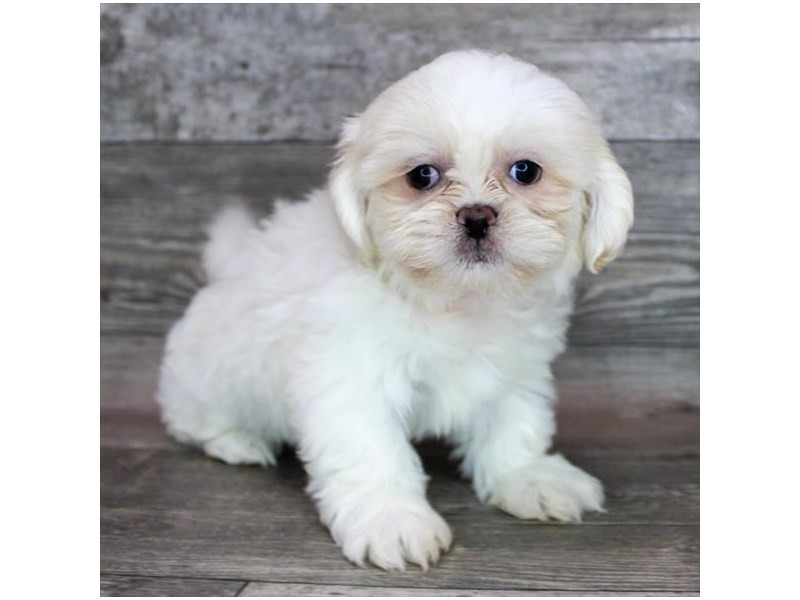
The all white Shih Tzu represents one of the most striking and sought-after variations of this ancient breed. Originally bred for Chinese royalty, these elegant dogs combine a pristine white coat with the classic Shih Tzu's affectionate temperament. Standing 8-11 inches tall and weighing 9-16 pounds, the white Shih Tzu is distinguished by its luxurious floor-length double coat, expressive dark eyes, and gentle disposition. While requiring dedicated grooming, these companion dogs offer a perfect blend of beauty and personality, making them increasingly popular as family pets. Their hypoallergenic qualities and adaptability to various living situations further enhance their appeal.
All White Shih Tzu
Distinctive White Coat Characteristics
The all white Shih Tzu showcases a pristine pure white coat that requires special attention to maintain its brightness. Unlike other Shih Tzu colors, the pure white coat is more prone to visible staining and discoloration, particularly around the face and paws. The white coloring comes from a specific genetic trait that inhibits pigment production in the fur.
Show Ring Requirements
For show ring competitions, all white Shih Tzus must meet strict coat standards. The fur should be completely white without any cream or beige tinting. Even slight color variations can disqualify them from competition. The coat must also maintain a silky texture and proper length between 8-11 inches when fully grown. Show dogs require daily grooming and regular whitening baths to keep their coats pristine for competitions.
White Shih Tzu Origins & History
Ancient Tibetan Roots
The white Shih Tzu's origins can be traced back to Tibet, where they were first bred by Tibetan monks over 2,000 years ago. These sacred dogs were often presented as gifts to Chinese emperors, leading to their eventual prominence in Chinese imperial courts. The white coloring was particularly prized among nobility, as it symbolized purity and refinement.
Near Extinction and Recovery
During China's Communist Revolution, the white Shih Tzu population was drastically reduced to just 14 surviving dogs - seven males and seven females. All modern white Shih Tzus descend from these 14 dogs that were used to reestablish the breed. After being introduced to the Western world in the 1930s, white Shih Tzus quickly gained popularity and were officially recognized by the American Kennel Club in 1943, marking their successful recovery from near extinction.
White Shih Tzu Physical Characteristics & Care
Distinctive Facial Features
White Shih Tzus have large, expressive dark eyes set far apart and a short muzzle with a distinctive furry mustache and beard. Their facial structure requires special attention as they are prone to tear staining around the eyes and food staining around the mouth area. Daily cleaning with pet-safe wipes helps maintain the pristine white appearance of the facial fur.
Specialized Grooming Requirements
White Shih Tzus need frequent bathing every 4-6 weeks with whitening shampoo to prevent yellowing of their coat. Their double-layered coat consists of a silky topcoat and soft undercoat that requires daily brushing to prevent matting. Special attention must be paid to areas prone to staining like paw pads and around the mouth. Using protective accessories like bibs during feeding and boots during walks can help maintain the coat's pure white appearance between grooming sessions.
All White Shih Tzu
Health Considerations
While white Shih Tzus share many common health issues with other coat colors, they face unique challenges due to their pure white coloring. Their lack of pigmentation makes them more susceptible to sunburn and skin sensitivities. Owners should use pet-safe sunscreen when these dogs spend extended time outdoors and monitor their skin regularly for signs of irritation or sunburn. Additionally, white Shih Tzus can be prone to deafness, a condition sometimes linked to the genes responsible for white coat coloring.
Exercise and Activity Needs
Unlike other small breeds, white Shih Tzus require moderate daily exercise of around 20-30 minutes, split into shorter sessions to prevent overexertion. Their brachycephalic facial structure makes them prone to breathing difficulties, so activities should be planned during cooler parts of the day. Indoor play sessions are ideal for maintaining their physical and mental stimulation while protecting their pristine coat from outdoor elements.
Conclusion
The all white Shih Tzu represents a unique and historically significant variant of the breed, characterized by its pristine pure white coat that requires specialized care and maintenance. These dogs trace their lineage back to ancient Tibet and survived near extinction during China's Communist Revolution, with all modern white Shih Tzus descending from just 14 dogs. Their distinctive appearance, including large dark eyes and short muzzle, makes them popular show dogs, though they must meet strict coat standards for competition.
The research highlights several key considerations for white Shih Tzu ownership, including their intensive grooming needs, susceptibility to coat staining, and health challenges related to their lack of pigmentation. Their moderate exercise requirements and need for protection from sun exposure require thoughtful care from owners. These findings emphasize the importance of dedicated maintenance routines and preventative health measures to ensure these beautiful dogs maintain both their striking appearance and overall wellbeing. For potential owners, understanding these unique care requirements is essential before choosing an all white Shih Tzu as a companion.